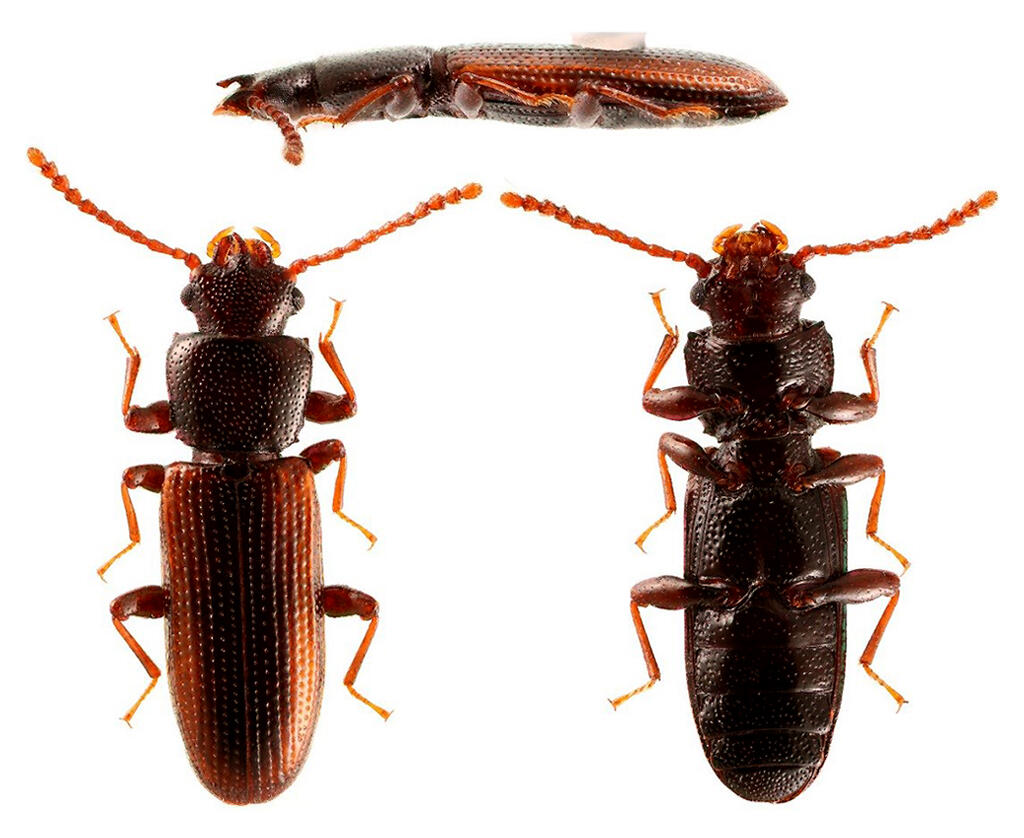A new species of beetle of the family Tenebrionidae was discovered in Nakanoshima, Tokara Islands. The new species was discovered by Assistant Professor Takahiro Yoshida of Tokyo Metropolitan University Graduate School of Science and Visiting Researcher Kiyoshi Ando of Ehime University Faculty of Agriculture. The new species has features not found in closely related species, such as a long, left-curved horn on the head and a male aedeagus twisted slightly to the right toward the tip. It was named Platycotylus merkli sp. nov. In the Japanese name "Tsujihiratahimekokunusutomodoki", "Tsuji" is named after the collector Naomichi Tsuji, and the scientific name "merkli" is named after Dr. Otto Merkl, the taxonomic authority on the family Tenebrionidae, who died suddenly this year.

Provided by Tokyo Metropolitan University
Tenebrionidae is a large family of beetles, consisting of approximately 20,000 species worldwide and more than 450 species in Japan, including Tenebrio obscurus and Tenebrio molitor, which are used in the pet industry as mealworms. The genus Platycotylus belongs to the family Tenebrionidae of the tribe Palorini. Although its distribution in Africa, Southeast Asia, and Taiwan is known, it had never been found in Japan. A famous biogeographic distribution boundary called Watase's line is drawn between Akusekijima and Kodakarajima in the Tokara Islands, which is located between Yakushima and Amami Islands, and it has become an important area for researching the biota of Japan. Doctoral Candidate Naomichi Tsuji of the Kyushu University Graduate School of Bioresource and Bioenvironmental Sciences Entomological Laboratory visited Nakanoshima in the Tokara Islands in July 2019 to collect beetles of an unknown family after obtaining permission to undertake research in the Tokara Islands. Mr. Tsuji entrusted the specimen to the lead author, Assistant Professor Yoshida, who consulted with Visiting Researcher Ando and Dr. Otto Merkl at the Hungarian Natural History Museum. As a result, it was revealed that this was a new species of the genus Platycotylus, which was previously unrecorded in Japan.
Only one male has been found in this new species, but it has a very characteristic morphology. The head has thick, long horns curved to the left. Normal males of this genus have a pair of small horns, but no other species is known to have a long single horn, as in the new species. The male aedeagus also has a special shape, twisted slightly to the right toward the tip. Other types of male aedeagus have a simple structure, and no male aedeagus with such a twisted structure has been found so far. There are also species of unknown males in this genus. However, it was found that these species can also be distinguished by the shape of the antennae, the shape of the stippling of the prothorax and back plate, the surface structure of the elytron, the size of the compound eye, and the shape of the temporal region. It became clear that it showed a morphology that could be clearly distinguished from these other species, and it was judged to be a new species. The shape of the new species of male aedeagus is special, but the morphology of the male aedeagus of the tribe Paralini, which includes the new species, is also unique within the family Tenebrionidae, and it twists 180 degrees in the opposite direction. The significance of such a unique male aedeagus morphology is not well understood.
On the other hand, it is known that a special group living in the male flower of the cycad of family Erotylidae also has a male aedeagus with a rotation of 180 degrees in the other direction and a twisted shape. It has been pointed out that these morphologies may be intended for mating (a mating posture in which the tips of the abdomen are butted against each other) without riding on a female, in the narrow space of male cycad flowers. In the family Laemophloeidae, which has a similar male aedeagus, a species has been observed that copulates with the tip of the abdomen butted against the tip of the other abdomen without actually riding on a female. The new species may have evolved a special male aedeagus to mate in a spatially constrained environment, such as under the bark of a dead tree. By advancing research on why these morphologies have evolved, we hope to improve our understanding of the diverse morphology of insects.
This finding reaffirms that there are still important discoveries to be made in the Tokara Islands. Going forward it is necessary to conserve the natural environment of Tokara Islands, which is biogeographically important, and to continue vigorous research.
This article has been translated by JST with permission from The Science News Ltd.(https://sci-news.co.jp/). Unauthorized reproduction of the article and photographs is prohibited.




